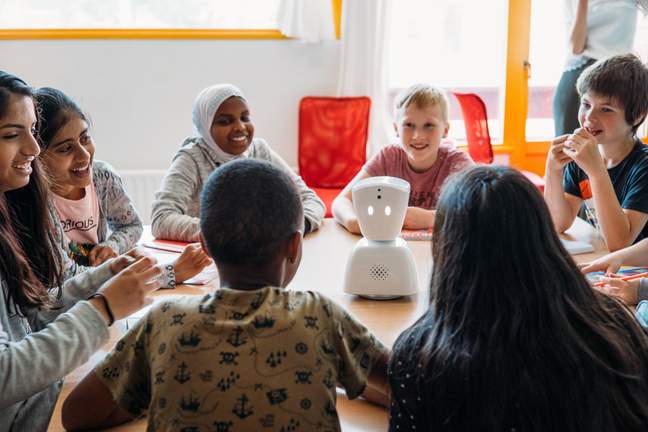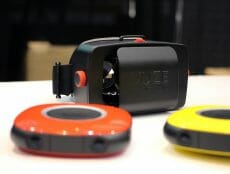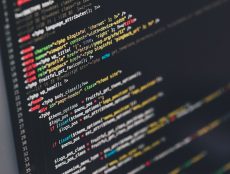
Editor’s Picks
Interviews
Meet AV1: A Robot that Helps Sick Kids Remain Present in the Classroom
By Cait Etherington
March 24, 2018
There have been many recent reports about the role telepresence robots are about to play in our lives, but one Norwegian-based startup is already using them to transform people’s lives on a profound level. No Isolation recently launched the AV1, which the company describes as “the world’s first telepresence robot specifically developed for children and young adults with long-term illness.”
Karen Dolva and colleagues, Marius Aabel and Matias Doyle, met in 2012 at Norway’s largest launch pad for tech startups. From the start, they imagined coming up with a tech solution to a pervasive problem: social isolation. As they brainstormed their idea, they realized the far-reaching impacts of social isolation and loneliness. In 2015, they launched No Isolation. In the company’s own words, No Isolation “tackles loneliness and involuntary social isolation by developing communication tools that can help those affected.”
eLearning Inside News recently caught up with CEO Karen Dolva to learn more about No Isolation, the AV1, and the company’s mandate to tackle social isolation with tech solutions.
How and Why the AV1 Came to Life
Cait Etherington: What initially led No Isolation to develop AV1? How did you realize there was a need for a telepresence robot in classrooms?
Karen Dolva: Both AV1 and No Isolation came as the result of meeting Anne Fi Troye, a mother who lost her teenage daughter, Cornelia, to cancer in 2005. Reflecting on her loss, Anna Fi noted that in the years following her diagnosis, the level of solitude Cornelia felt was “much worse than the diagnosis, the pain and the treatment.” Anna Fi was already trying to find ways to reduce the loneliness of other children in Cornelia’s situation when we met, and I knew I needed to help.
I, with my co-founders at No Isolation, immediately began researching the solutions that already existed and was shocked to learn that there was very little technology in place to help those suffering from long-term illness stay connected to the outside world. From speaking with various charities and organizations we knew that we wanted to build a tool that would allow children to participate both in their studies and in their social lives, so that they’d not fall behind in any area.
We actually didn’t know we’d be making a telepresence robot when we started – it was only through testing ideas with different children that AV1 began to form.
CE: Why is AV1 a better option than simply a remote monitor? After all, couldn’t students just use Facetime or Skype to be present at a distance? Why is this a more effective option?
KD: The main difference is security and control – with AV1 the child chooses when they log on and where they look, and it is safe and secure in a classroom situation because no data is stored – everything is transferred in real-time.
Also, the difference between AV1 and something like FaceTime or Skype is that AV1 has a one-way camera. During our prototype testing, we found that children preferred this, as they didn’t need to worry about how they looked to their classmates, especially if they were feeling particularly poorly on any given day.
Additionally, No Isolation’s AV1 is a physical robot that can mimic certain human gestures. For example, the user can use the robot to physically turn and look at whoever is speaking and can use their controller to nod, shake their head and move around on a 360-degree axis. We also added a ‘whisper mode’, where the user can speak quietly via their AV1 in class, rather than projecting their voice to the whole room. This creates a much more compelling and physical presence.
Most importantly though, AV1 is designed to be picked up and moved around. Our users can go out to the playground or the canteen at break time and won’t miss out on socializing with their friends. AV1’s also go on field trips and on family outings. We know of AVs that have been to the zoo, have been kayaking and that have been to concerts and theatre shows. By creating an avatar that is physically present, it is easier for the child to feel as though they are actually there, and for their classmates to involve them.
Reactions to the AV1
CE: How do children who are present in the classroom respond to No Isolation’s AV1? Do they think it’s weird to have their classmate mediated by a robot, or does the presence of the robot, in fact, add to the classroom dynamic?
KD: Interestingly, we find that the younger the kids, the more quickly they adapt to the technology! After a few minutes, they forget that there is a robot in class, and view it simply as their friend. It is the adults that take a little longer to get used to the idea.
Speaking with our users in the UK, we’ve heard that their classmates have all been very excited when an AV1 has been introduced into the classroom, and have asked lots of questions about how and why the technology is helping their friend. In fact, we’ve even heard that one child actually told a mother of a user that he wished his other friend who was currently off school with a long-term illness had access to an AV1, which is incredibly heartwarming.
No Isolation’s Success Stories
CE: Can you share a success story?
KD: One of our users is a 12-year-old boy called Elliot, who is recovering from surgery to remove a brain tumor. As a result of his treatment, surgery and recovery, Elliot has been forced to miss a lot of school. He’s also been incredibly self-conscious about his appearance, as a result of his illness, so has been reluctant to see his friends.
His teachers at Preston School, Somerset, were incredibly keen to help him get back up to speed, and so raised funds to purchase an AV1 for him to use. Now that Elliot has access to an AV1, he is able to attend class remotely – meaning that he is catch up on his studies and slowly begin to re-integrate himself back into school life on his terms.
CE: How much will it cost for schools or families to adopt an AV1? Do you have plans to make access to AV1 accessible, even to families who may be struggling financially?
KD: AV1 is available to rent in the UK, with prices for parents beginning at £280/month (including insurance and support) for users who expect to be away for less than six months, extending to £1800/year (including insurance and support) for those who have to be away for more than six months.
Organisations in the public sector, such as schools, can purchase AV1 through Atea – Northern Europe’s market leader in IT infrastructure. Each avatar is sold at £2200 with a £90 extra monthly fee for 4G, support, and insurance. This monthly fee enables the school to contact No Isolation for tech assistance or a change of user, should the school wish to recycle the avatar once the pupil has returned to school.
We understand that loneliness and isolation affect thousands of people of varying financial circumstances, which is why an AV1 can be donated to a user or a school by a company, organization or foundation.
No Isolation’s New Project Aims to Transform Seniors’ Lives
CE: What’s next for No Isolation? Do you have other projects in development at the moment or plans to expand AV1’s presence in other contexts?
KD: Our next product, KOMP, is aimed at solving the loneliness epidemic among seniors. We have conducted extensive research into this topic and found that many seniors wished they could talk to their family more, while the family members felt guilty for not talking to their elderly relatives enough. We also learnt that while many families would give their elderly relatives devices like tablets and computers, many seniors found the systems too complex and not adapted for reduced hearing, touch and eyesight. We wanted to create something that would address all of these issues and reduce loneliness in seniors.
KOMP allows seniors to passively receive images, messages and video calls. It has one button, a large screen, and quality loudspeakers. The button allows for the device to be turned on and off, as well as controlling the volume. There is no touchscreen, and there are no pop-up messages, log-in details, emails or passwords.
The content in KOMP is managed from the connected app. Family and friends send messages, images and start video conversations. When video calling, the KOMP screen lights up and automatically starts counting down from 10. If the user wants to receive the call they just let it count down and it automatically starts, while if they want to reject the call they turn their KOMP off. If it is turned off already, the KOMP will call as a normal phone and the senior needs to turn it on to receive the call.
Having proven its success in Norway, with more than 200 seniors using KOMP, No Isolation’s product will be coming to the UK very soon, and is available for pre-order now.









No Comments